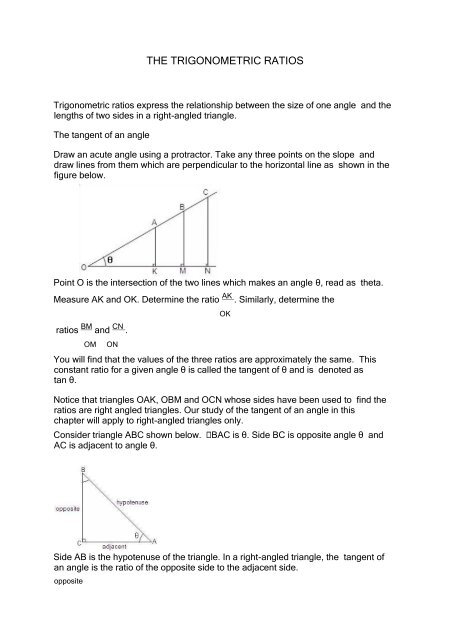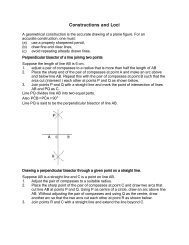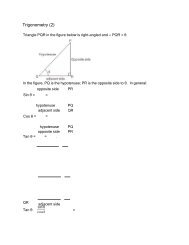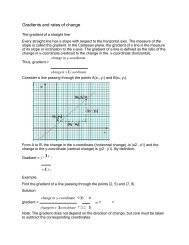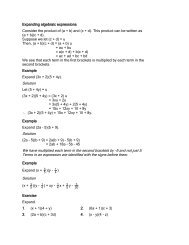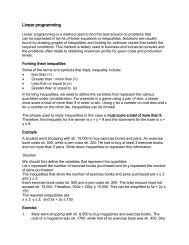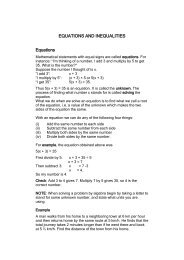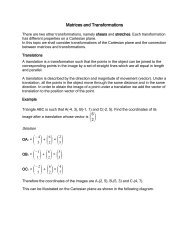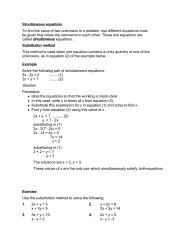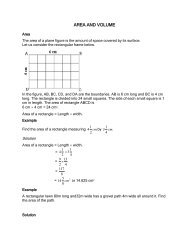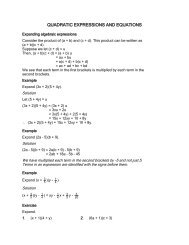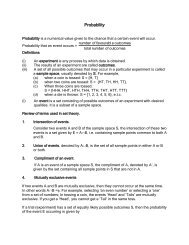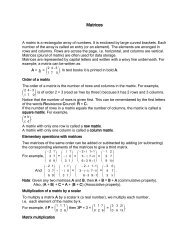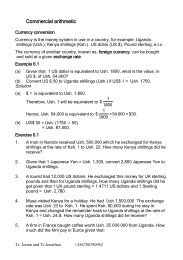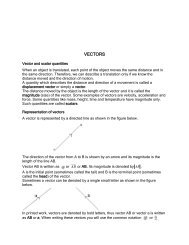J12
You also want an ePaper? Increase the reach of your titles
YUMPU automatically turns print PDFs into web optimized ePapers that Google loves.
THE TRIGONOMETRIC RATIOS<br />
Trigonometric ratios express the relationship between the size of one angle and the<br />
lengths of two sides in a right-angled triangle.<br />
The tangent of an angle<br />
Draw an acute angle using a protractor. Take any three points on the slope and<br />
draw lines from them which are perpendicular to the horizontal line as shown in the<br />
figure below.<br />
Point O is the intersection of the two lines which makes an angle θ, read as theta.<br />
Measure AK and OK. Determine the ratio AK . Similarly, determine the<br />
ratios BM and CN .<br />
OM<br />
ON<br />
You will find that the values of the three ratios are approximately the same. This<br />
constant ratio for a given angle θ is called the tangent of θ and is denoted as<br />
tan θ.<br />
Notice that triangles OAK, OBM and OCN whose sides have been used to find the<br />
ratios are right angled triangles. Our study of the tangent of an angle in this<br />
chapter will apply to right-angled triangles only.<br />
Consider triangle ABC shown below.<br />
AC is adjacent to angle θ.<br />
OK<br />
BAC is θ. Side BC is opposite angle θ and<br />
Side AB is the hypotenuse of the triangle. In a right-angled triangle, the tangent of<br />
an angle is the ratio of the opposite side to the adjacent side.<br />
opposite
Thus, tan θ .<br />
adjacent<br />
Exercise<br />
1. Name the sides which are opposite and adjacent to the angle marked θ in each
When the angles are known, we use the table of tangents to find the ratios of the<br />
opposite to the adjacent sides. Angles in the table of tangents are expressed in<br />
degrees and points of degrees. They are also given in minutes.<br />
There are 60 minutes (60’) in 1 degree (1 0 ). Thus, 60’ is equivalent to 1 0 . There are<br />
three major groups of columns in the table of tangents as in table 12.1.<br />
1. The column headed θ gives angles in degrees.<br />
2. The next 10 columns headed 0.0 0 to 0.9 0 or 0’ to 54’ give the tangents of angles.<br />
Angles increase in steps of 6’ or one-tenth of a degree which is 0.1 0 .<br />
3. The last five columns headed 1’ to 5’ are called differences and indicate<br />
hundredths of degrees.<br />
Example<br />
Find tan 12.8 0 .<br />
Solution<br />
To find tan 12.8 0 , proceed as follows:<br />
In the column headed θ, look for the row headed 12. Move along this row until you<br />
reach the column headed 0.8. The number at the intersection is 0.2272. Therefore,<br />
tan 12.8 0 = 0.2272. Note: 12.8 0 = 12 0 48’<br />
In order to find tan 12 0 48’ read the number where the row headed 12 0 meets with the<br />
column headed 48’.<br />
Example<br />
Find tan 12 0 45’<br />
Tan 12 0 45’ cannot be read directly from the table because there is no column for 45’.<br />
12 0 45’ lies between 12 0 42’ and 12 0 48’ both of whose tangents can be directly read<br />
from the tables.<br />
Since 12 0 45’ is 3’ more than 12 0 42’, the difference between their tangents is the<br />
number at the intersection of the row headed 12 0 and the column headed 3’, that is,<br />
0.0009. This difference is then added to the value of tan 12 0 42’. Thus, tan12 0 45’ = tan<br />
(12 0 42’ + 3’)<br />
= 0.2263<br />
= 0.2254 + 0.0009<br />
Note: 12 0 45’ is also 3’ less than 12 0 48’.<br />
The corresponding difference in their tangents is also 0.0009. This difference is<br />
subtracted from the value of tan 12 0 48’.<br />
Thus, tan12 0 45’ = tan 12 0 48’ – tan 3’
Exercise<br />
= 0.2272 – 0.0009<br />
= 0.2263<br />
Use tables to find the tangents of the following angles:<br />
1. 18 0 2. 80 0<br />
3. 37 0 4. 5 0<br />
5. 15.3 0 6. 44.9 0<br />
7. 54.2 0 8. 7 0 15’<br />
9. 63 0 50’ 10. 72 0 35’<br />
11. 88 0 48’ 12. 20 0 58’<br />
Using tangents in calculations<br />
Example<br />
Find length AB in triangle OAB<br />
Solution<br />
Tan 400 =<br />
AB AB OB<br />
15<br />
AB = 15 tan 40 0<br />
= 15 × 0.8391 (from the tables) = 12.6 cm.<br />
Example<br />
Find length PQ in triangle PQR.
Solution<br />
Tan 70 0 21’ = 45<br />
PQ<br />
Hence, PQ = 45<br />
= 16.07 cm.<br />
=<br />
45<br />
tan 70 0 21 '<br />
2 .800<br />
Example<br />
Find the size of angle θ in the figure below.<br />
Solution<br />
Tan θ = 3.5 = 0.4605<br />
7.6<br />
We need to find an angle, θ, whose tangent is 0.4605. In this case, the process of<br />
finding the tangent of an angle is reversed. From the table of tangents, locate the<br />
number 0.4605 or if it is missing, locate the nearest number smaller than it. The<br />
closest smaller tangent to 0.4605 is 0.4599, the tangent of 24 0 42’. The difference<br />
between 0.4605 and 0.4599 is 0.0006. Look for 6 (or the closest number) in the
difference columns along the row headed 24. The number closest to 6 is 7 in the<br />
column headed 2’. Thus, the angle whose tangent is 0.4605, is 2’ more than 24 0 42’.<br />
Therefore, θ = 24 0 42’ + 2’<br />
= 24 0 44’<br />
Exercise<br />
1. Use tangents to find the lengths of the sides marked x in each of the following
its angles.<br />
Applications of tangents Elevation and<br />
Depression<br />
(alternate angles).<br />
Example<br />
A boy, 120 cm tall, is standing 50 m from a flag post on a level ground. He finds that<br />
the angle of elevation to the top of the flag post is 15 0 . Calculate the height of the<br />
flag post.<br />
Solution
= 13.4 m.<br />
Tan 15 0 = BC (see diagram below)<br />
50<br />
Therefore, BC = 50 tan 15 0<br />
= 50 × 0.2679<br />
This is the height of the flag post above the boy’s height of 1.2 m. Therefore, the<br />
height of the flag post is 13.4 + 1.2 = 14.6 m.<br />
Example<br />
A girl lying at the top of a cliff, 120 m high sees two rocks whose angles of depression<br />
are 10 0 and 30 0 . If the rocks are in line with the foot of the cliff, find the distance<br />
between the rocks.<br />
In MBF, tan 10 0 = 120
= 120 = 681 m. tan100 0.1763<br />
FB Therefore, FB = 120<br />
The distance between the rocks is<br />
m.<br />
AB = FB – FA = 681 – 208 m = 473<br />
Alternatively, in MFA, AMF = 60 0 .<br />
Thus tan 60 0 = AF = AF<br />
MF 120<br />
Therefore, AF = 120 × 1.132 = 208 m.<br />
And in FMB, BMF = 80 0 . Thus, tan 80 0 = FB<br />
Therefore, FB = MF tan 80 0 = 120 × 5.671 = 681 m. AB = FB –<br />
AF = 681 – 208 = 473 m.<br />
Exercise<br />
1. An angle of elevation of P from Q is 62 0 . What is the angle of depression of Q<br />
from P?<br />
MF<br />
2. What is the angle of elevation of the top of a building, 30 m tall, from a point on<br />
the ground 80 m away?<br />
3. A ladder leans against a vertical wall making an angle of 15 0 with the wall. If its<br />
foot is 4 m from the wall, calculate the height above the ground of the top of the<br />
ladder.<br />
4. A vertical tower, 40 m tall, casts a shadow on a level ground. Calculate the<br />
angle the rays of the sun make with the ground.<br />
5. The angle of elevation to the top of a tree from a point on the ground 70 m<br />
from its foot is 18 0 . Calculate the height of the tree.<br />
6. Calculate the angles of a rhombus whose diagonals are 14 cm and 8 cm.<br />
7. P is 15 km north of Q and R is 26 km west of P. Calculate the bearing of R from<br />
Q.<br />
8. From the top of a rock, a boy sees a pawpaw tree 30 m away. He measures the<br />
angle of elevation of the top of the tree as 15 0 and the angle of depression at the<br />
bottom as 4 0 . Calculate the height of the pawpaw tree.
9. Two boys standing on opposite sides of a tree 24 m tall, measure the angles of<br />
elevation of its top as 36 0 and 23 0 . Calculate the distance between the two<br />
boys.<br />
10. A tree that is 20 m from a busy path is being cut down. The angle of elevation<br />
of the top of the tree from the middle of the path is 50 0 . Is it safe for the tree to<br />
fall in the direction of the path?<br />
11. How far from the base of a 25 m cliff must a ship be so the angle of elevation<br />
of the top of the cliff from the ship is to be 7 0 ?<br />
12. The angle of elevation of the top of a building is 70 0 from a point on the ground<br />
50 m away.<br />
(a)<br />
How high is the building?<br />
(b) What would be the angle of elevation of the top of the building from a<br />
point on the ground 25 m away?<br />
13. The angle of depression of a crossroads from an aero plane flying at 400 m is<br />
20 0 .<br />
(a)<br />
(b)<br />
What is the horizontal distance of the plane from the crossroads?<br />
What would the angle of depression have been if the plane had been<br />
flying at 600 m at the same horizontal distance away?<br />
14. The angle of elevation of the top of a chimney on a house from a point on the<br />
ground 50 m away is 22 0 .<br />
(a)<br />
(b)<br />
How high above the ground is the top of the chimney?<br />
If the angle of elevation of the roof of the house from the same point is<br />
20 0 , how tall is the house? (c) How tall is the chimney?<br />
15. The angle of depression of a house from the top of a 175 m hill is 75 0 . (a)<br />
How far is the hill from the house, horizontally?<br />
(b) If the angle of depression of a church from the top of the hill is 62 0 ,<br />
How far is the hill from the church, horizontally?<br />
(c)<br />
Assuming that the hill, house and church are all in the same straight line,<br />
how far is it from the house to the church?<br />
16. (a) The angle of elevation of the top of a cliff from a ship at sea level is<br />
12.3 0 . If the ship is 2.3 km out to sea find the height of the cliff.<br />
(b) A 50 m lighthouse stands on the top of the cliff. Find the angle of<br />
depression of the ship from the top of this lighthouse.<br />
The sine of an angle<br />
We have seen that for any right-angled triangle ABC, the ratio of the opposite side to<br />
the adjacent side is a constant fro a given angle, θ.
Similarly, the ratio of the opposite to the hypotenuse is a constant for any given<br />
angle, θ. This constant is called the sine of angle θ, abbreviated as sin θ and read as<br />
sine theta.<br />
sin θ = .<br />
opposite Thus,<br />
hypotenuse<br />
The table of sine<br />
The table of sines is read in the same way as the table of tangents. For example,<br />
sin 24 0 = 0.4067 and sin 43 0 46’ = 0.6909 + 0.0009 = 0.6918 Exercise<br />
1. Write down the sines of each of the following angles:<br />
(a) 13 0 (b) 76 0<br />
(c) 44.3 0 (d) 50 0 24’<br />
(e) 32 0 19’ (f) 18 0 16’ 2.<br />
Write down the angles whose sines are:<br />
(a) 0.8746 (b) 0.3272<br />
(c) 0.8398 (d) 0.3555<br />
(e) 0.6000 (f) 0.9927<br />
Applications of sines<br />
Example<br />
Find the length of PR in the following diagram.
Solution<br />
Sin 38 0 = PR = PR<br />
RQ 80<br />
Thus, PR = 80 sin 38 0<br />
= 80 × 0.6157 = 49.3 cm.<br />
Example<br />
Find the size of angle θ in the following diagram.<br />
Exercise<br />
Solution<br />
Sin θ = = 0.4615<br />
θ = 27 0 29 ’<br />
1. Find the length of the side marked x in each of the following right-angled<br />
triangles:<br />
(a)<br />
(b)
2. Find the size of the angle marked θ in each of the following right-angled<br />
triangles:
( a ) ( b)<br />
( c) ( d)<br />
3. In triangle ABC below, find the length of BC.<br />
4. An isosceles triangle with its base 18 cm long, has each of the identical angles<br />
as 43 0 . Find the lengths of the identical sides.<br />
5. In the figure below, triangles ABC and ABD are right-angled.
Find: (a) BAD, (b) the length of BC.<br />
6. Find the base length of an isosceles triangle whose vertex angle is 50 0 and the<br />
equal sides are 10 cm long.<br />
7. An isosceles triangle has a base of 6 cm and the equal sides are each 8<br />
cm long. Find the angles of the triangle and its height.<br />
8. Find the angle subtended at the centre of a circle of radius 5 cm by a chord of<br />
length 3 cm.<br />
The cosine of an angle<br />
In any right-angled triangle, the ratio of the adjacent side to the hypotenuse is a<br />
constant for any given angle, θ. This constant ratio is called the cosine of angle θ,<br />
abbreviated as cos θ.<br />
Thus, cos θ = .<br />
a d ja ce nt<br />
hyp o te nuse<br />
The table of cosines<br />
You will have noticed that the sines and tangents of angles increase as the angles<br />
increase. In the table of cosines, the cosine of angles decrease as the angles<br />
increase.<br />
The cosines of angles are read in the same way as the sines except that the values<br />
in the columns of differences of the cosines are subtracted instead of being added.<br />
Example<br />
(a) Find cos 35 0 22’.<br />
(b) Find the angle whose cosine is 0.6890<br />
Solutions<br />
(a) From the tables, cos 35 0 22’ can be found by getting cos 35 0 18’
Cos 28 0 14΄ = AB = 40 AC AC<br />
Cos 35 0 18’ = 0.8161<br />
35 0 22’ – 35 0 18’ = 4’<br />
Therefore, cos 35 0 22’ = 0.816 – 0.0007 = 0.8154<br />
(b) From the tables, 0.6890 lies between 0.6664 and 0.6896 in the row headed 46.<br />
0.6896 is 0.0006 more than 0.6890. We look for 6 or a number nearest to 6 in<br />
the differences column on the row headed 46 0 . The number 6 is in the column<br />
3’. The angle whose cosine is 0.6890 is 46 0 24’ + 3’ = 46 0 27’. Exercise<br />
1. Find the cosine of each of the following angles:<br />
(a) 23 0 (b) 48 0 17’<br />
(c) 67 0 9’ (d) 83 0 34’<br />
(e) 42.6 0 (f) 15.7 0<br />
2. Use tables to find the angles whose cosine are: (a)<br />
0.2554 (b) 0.0870<br />
(c) 0.8895 (d) 0.5978<br />
(e) 0.4970 (f) 0.9998<br />
Applications of cosines<br />
Example<br />
Find AC in the following diagram.<br />
Solution<br />
AC = 40 = 40 = 45.4 m. cos28014 0.8810
Example<br />
Find the size of angle θ in the following diagram.<br />
Exercise<br />
Solution<br />
Cos θ = = 0.5385 θ<br />
= 57 0 25 ΄ (from tables)<br />
1. Find the lengths of the sides marked x in the following right-angled triangles:<br />
(a) (b)
2. Find the value of θ in each of the following right-angled triangles:<br />
(a) (b)<br />
3. A diagonal of a rectangle is 20 m long and makes an angle of 40 0 with one of<br />
the sides. Calculate the lengths of the sides of the rectangle.<br />
4. A rectangle 12 cm wide has a diagonal of 20 cm. Calculate the acute angle<br />
between the diagonals.
5. A ladder 8 m long is leaning against a vertical wall, with its foot 2 m from the<br />
wall. Calculate the angle the ladder makes with the floor.<br />
6. A chord of a circle 13 cm long subtends an angle of 118 0 at the centre. Find the<br />
radius of the circle.<br />
7. A girl starts from village P, walks 300 m on a bearing of 038 0 to village Q, and<br />
then walks 60 m on a bearing of 073 0 to R. Find how far east R is from P.<br />
8. An isosceles triangle ABC is such that AB = BC = 16.5 cm, and ABC = 80 0 24΄.<br />
Find the length of its altitude.<br />
Tangents, sines and cosines<br />
Consider a right-angled triangle PQR.<br />
In the diagram above, sin θ = QR and cos θ = PR .<br />
PQ<br />
PQ<br />
=<br />
sin θ<br />
QR ÷ PR = QR × PQ = QR Therefore,<br />
cos θ PQ PQ PQ PR<br />
PR<br />
Also, tan θ = QR .<br />
PR<br />
Therefore,<br />
tanθ<br />
Example<br />
A metallic pipe 12 m long is leaning against a vertical wall, with its foot 3 m from the<br />
wall.<br />
(a)<br />
Find the angle the pipe makes with the horizontal.
(b)<br />
Find the height of the wall where the pipe reaches.<br />
Solution<br />
Let the angle be θ and the height be h.<br />
( a ) cos θ = = 0.25<br />
Therefore, θ = 75 0 31 ΄<br />
( b ) sin 75 0 h<br />
31 ΄ =<br />
12<br />
That is, h = 12 sin 75 0 31΄ = 12 × 0.9682 = 11.6 m.<br />
The ratios of sine, cosine and tangent are best remembered by the acronym<br />
SOHCAHTOA.<br />
Where, SOH means, Sine =<br />
CAH means, Cosine =<br />
means. Tangent = .<br />
Hypotenuse<br />
Opposite TOA<br />
Adjacent<br />
Opposite<br />
Hypotenuse Adjacent<br />
Example<br />
Find without using tables, the value of sin θ and tan θ, if cos θ =<br />
and θ is an acute<br />
angle.
Solution<br />
adjacent<br />
Cos θ = hypotenuse<br />
.<br />
Draw following diagram.<br />
ABC and indicate the sides as in<br />
the AB = 4 units and AC = 5 units. Using Pythagoras’ theorem,<br />
BC 2 = AC 2 – AB 2<br />
= 5 2 – 4 2<br />
= 9<br />
BC = 3<br />
Sin θ = BC 3 and tan θ = BC 3<br />
AC 5 AB 4<br />
Also, tan θ = = ÷ = × = .<br />
Exercise<br />
1. Given that tan x = , find cos x and sin x.<br />
2. Given that cos x = , find sin x and tan x. 3.<br />
Given that sin x = , find cos x and tan x.<br />
4. Given that tan x = , find cos x and sin x.<br />
5. If tan x =<br />
5 cosx sinx<br />
, evaluate<br />
12 sinx<br />
cosx
6. The shadow of a building, on a horizontal ground, is twice as long as its height.<br />
If its height is 25 m, calculate the angle of elevation to the sun from the ground.<br />
7. In the figure below, calculate the lengths of lines: (a) AD (b) AB<br />
(c)<br />
BC<br />
STATISTICS<br />
Statistics is that branch of mathematics which is concerned with the collection,<br />
organization, interpretation, presentation and analysis of numerical data. To a<br />
statistician, any information collected is called data. When data has not been ordered<br />
in any specific way after collection, it is called raw data.<br />
Representation of data<br />
Frequency tables (distributions)<br />
The frequency of an event is the number of times that the event occurs. While<br />
counting the scores, a tally mark, /, is made for every count and the fifth stroke<br />
crosses over the other four to have . Example<br />
Forty people were asked to judge which of five paintings, labeled A, B, C, D and E,<br />
was the best. The results are given below.<br />
B C B B D A E A<br />
C C A A B D E A B D B B B<br />
C A D<br />
E B C A A C D B<br />
C C A D B B D A<br />
If a prize was given for the picture with the most votes, which picture won?
Solution<br />
First we put the data into a frequency distribution (frequency table). This is a table<br />
which gives each data item together with the number of times they occur.<br />
Painting<br />
Tallies Frequency<br />
A<br />
B<br />
C<br />
D<br />
E<br />
Total<br />
10<br />
12<br />
8<br />
7<br />
3<br />
40<br />
Painting B, with twelve votes, wins the prize.<br />
The above data may be displayed in various ways.<br />
Bar chart:<br />
Bar charts or graphs can be used to make quick comparison of data. They are either<br />
horizontal or vertical, jointed or disjointed. The height or the length of the bar<br />
represents the frequency and its width is not significant.<br />
The bar graph for the above data can thus be drawn as follows.
Pie Chart:<br />
In a pie chart, each number is represented by the area of a sector of a circle. The<br />
frequency is proportional to the angle of the sector.<br />
The forty votes are represented by 360 0 (a full turn); thus one vote is represented by<br />
360 0 40 = 9 0 .<br />
Frequency<br />
Angle<br />
A 10 10 9 = 90 0<br />
B 12 12 9 = 108 0<br />
C 8 8 9 = 72 0<br />
D 7 7 9 = 63 0<br />
E 3 3 9 = 27 0<br />
Line graphs
A line graph is used to show how things change over a period of time. For example: A<br />
student obtained the following marks in six mathematics weekly tests. Draw a line<br />
graph to represent this information.<br />
Test 1 2 3 4 5 6<br />
marks 60 65 80 75 85 90<br />
To draw the line graph, mark the test numbers on the horizontal axis and the marks<br />
on the vertical axis. Plot the ordered pairs on the graph with dots as shown in the<br />
figure below. To obtain the line graph, join the dots with straight lines.<br />
Measures of central tendency<br />
These are values about which the distribution of data in a particular se may be<br />
approximately balanced. The common ones include the mean, median and mode.<br />
The mean ( x)<br />
The mean is the value obtained when the total sum of the values of the members in a<br />
list or distribution is divided by the total frequency.<br />
Example<br />
The masses (in kilograms) of nine students are 42, 47, 52, 57, 62, 67, 72, 77 and 82.<br />
Calculate their mean mass.<br />
Solution<br />
Add all the masses together and divide by 9.
The sum of the masses is 558 kg. The total<br />
number of students is 9.<br />
The mean mass is<br />
= 62 kg.<br />
Example<br />
Find the mean of the following frequency distribution.<br />
Solution<br />
x 1 2 3 4 5 6<br />
f 2 4 1 3 3 3<br />
To calculate the mean of the above data the following steps are followed.<br />
• Multiply each frequency (f) by its corresponding value (x) to obtain the product<br />
(f.x)<br />
• Find the sum of the products, (f.x), and then divide this sum by the sum of the<br />
( f . x )<br />
frequencies (f) to obtain the mean, i.e. x f<br />
x f f.x<br />
1 2 2<br />
2 4 8<br />
3 1 3<br />
4 3 12<br />
5 3 15<br />
6 3 18<br />
f=16<br />
f.x = 58<br />
The mean, x = 3.625.<br />
In statistics, the symbol (sigma) is used to mean the sum of. Thus, the sum of the<br />
frequencies (f) is written as f and the sum of the products (f.x) is written as fx.<br />
The median<br />
Median is the middle value of a given set of data when all the entries are arranged in<br />
order of size. It is the point at which exactly half of the data are above and half are<br />
below.
In ungrouped data, if the total number of members in a list is odd, the median position<br />
is a whole number given by (n 1) th member of the group. This formula gives the<br />
position at which the median is found in ranked data. To get the median, we go back<br />
to the ranked data and look for the value or entry at the position obtained from the<br />
calculation. When the position is not a whole number, we get the average of the<br />
values just before and just after the one obtained through the computation.<br />
Example<br />
Find the median of each of the following lists of numbers.<br />
(a) 1, 7, 1, 6, 2, 5, 2, 5, 2, 5, 3, 5, 3, 4, 4.<br />
(b) 29, 12, 25, 14, 18, 21, 18, 20, 19, 20.<br />
Solutions<br />
(a)<br />
Rearranging the numbers in order of size, we have:<br />
1, 1, 2, 2, 2, 3, 3, 4, 4, 5, 5, 5, 5, 6, 7<br />
The number of members (n) is 15. The median is the (15 1)th member. That is<br />
the 8 th member. From the ordered list, the 8 th member is 4. The median is 4.<br />
(b)<br />
Rearranging the numbers in order of size, we get:<br />
12, 14, 18, 18, 19, 20, 20, 21, 25, 29<br />
The number of members (n) is 10. The median position is given by<br />
(10 1)= 11 = 5.5<br />
This means that the median value falls between the 5 th and 6 th members in the<br />
ordered data, and its value is their average.<br />
The 5 th and 6 th members are 19 and 20 respectively. Therefore, the median is<br />
= 19.5.<br />
The median does not need to be among the numbers in the set of data.<br />
The median of an ungrouped frequency distribution<br />
In order to find the median using cumulative frequencies or the number of members<br />
that lie above or below a particular value in a set of data, we must calculate the first<br />
value with a cumulative frequency greater than or equal to the median.<br />
Example<br />
Find the median of the following distribution.<br />
x 2 3 4 5 6 7 8<br />
f 4 8 20 20 2 2 4
Solution<br />
The total frequency, f = 60. The median position is (60 1) = 30.5. This means the<br />
median value lies between the 30 th and 31 st values in the ordered data and its value<br />
is their mean.<br />
In order to get the 30 th and 31 st values, we need to make a cumulative frequency<br />
table as shown below.<br />
x Freq.<br />
Cumulative frequency<br />
(f) (cf)<br />
2 4 4<br />
3 8 12<br />
4 20 32<br />
5 20 52<br />
6 2 54<br />
7 2 56<br />
8 4 60<br />
The cumulative frequency is obtained by adding all the frequencies below and up to<br />
and including the particular value. From the table, we can see that the cumulative<br />
frequency corresponding to x = 8 is 60. This is the total number of observations in the<br />
distribution. From the cumulative frequency it can be seen that the 30 th member is 4<br />
and the 31 st member is also 4. Therefore, the median is = 4.<br />
The mode.<br />
The mode of a distribution is the most frequently occurring value. In a frequency<br />
distribution, the mode is the value with the highest frequency.<br />
Example<br />
Find the mode of the following set of numbers. 2, 4,<br />
4, 5, 7, 7, 7.<br />
Solution<br />
The mode is 7 as this appears three times.<br />
Example<br />
Find the mode of the following frequency distribution.
(a)<br />
x 3 4 5 6 7<br />
(b)<br />
f 1 3 8 10 4<br />
x 12 13 14 15 16<br />
f 6 9 9 3 5<br />
Solutions<br />
(a) The mode is 6.<br />
(b) The mode is 13 and 14 as these have the highest frequency.<br />
Exercise<br />
1. Find the mode, mean and median of the following sets of numbers<br />
(a) 3, 5, 6, 8, 9, 9, 9<br />
(b) 10, 10, 10, 20, 30, 30, 30, 30. (c)<br />
7, 1, 3, 5, 2, 9, 1.<br />
2. The mean of 4 numbers is 8. If three of the numbers are 4, 5 and 10, find the<br />
fourth number.<br />
3. The total of the heights of twenty-six girls was 41.86 m. Find the mean height of<br />
the girls.<br />
4. In a year, a student scored the following marks in tests and examinations.<br />
Term Test 1 Test 2 Test 3 Exams<br />
1 75 51 62 49<br />
2 54 45 64 74<br />
3 80 60 67 39<br />
Calculate the student’s mean score.<br />
5. The number of litres of milk delivered to 50 houses on one morning is shown<br />
below.<br />
No. of litres 1 2 3 4 5 6
No. of<br />
house<br />
10 14 18 4 2 2<br />
Calculate the mean number of litres delivered per house.<br />
6. The table below shows the marks scored by students in a test.<br />
Mark 0 1 2 3 4 5<br />
No. of<br />
students<br />
2 6 15 8 10 2<br />
Calculate the mean and median mark.<br />
7. The lengths, in centimeters, of 10 nails are: 3.01, 2.96, 3.04, 2.98, 3.00, 2.97,<br />
2.99, 3.02, 3.03, and 2.94. Find the median length of the nails.<br />
8. The number of goals scored in super league matches is shown in the table<br />
below.<br />
Goals frequency<br />
0 10<br />
1 20<br />
2 10<br />
3 6<br />
4 9<br />
4 8<br />
Calculate the mean and median number of goals scored. State the modal<br />
number of goals scored.<br />
9. A company’s costs are split into the following categories.<br />
Wages 45%<br />
Rates 15%<br />
Materials 30%<br />
Transport 10%<br />
Show this information in a pie chart.
10. A group of fifty year olds were asked how much television they had watched on<br />
a particular evening. Their answers, to the nearest hour, are shown below.<br />
(a)<br />
1 3 0 3 1 4 5 4 3 2<br />
0 4 6 2 2 2 3 2 2 7<br />
3 1 0 2 3 3 0 1 7 2<br />
5 4 2 1 1 3 4 2 4 4<br />
0 0 1 2 1 3 1 2 7 2<br />
Set up a frequency distribution to represent this information.<br />
(b) Draw a bar chart to show the above data. (c) State the modal time.<br />
11. Various types of large white loaves are delivered to a supermarket. The number<br />
of each type delivered on a particular day is shown below.<br />
Thin sliced 45<br />
Medium sliced 84<br />
Thick sliced 15<br />
Uncut 36<br />
(a) In a pie chart, what angle would represent 1 loaf? (b) Display the above<br />
information in a pie chart.<br />
12. The bar chart below shows the number of pages per day in the New Vision<br />
news paper for 20 days during a certain month.<br />
(a)<br />
(b)<br />
State the modal number of pages.<br />
Calculate the mean and median number of pages.<br />
13. The table below shows the number of letters collected by a school from the post<br />
office in the first six weeks of the term.<br />
Week 1 2 3 4 5 6<br />
No. of 80 110 120 160 110 120<br />
letters<br />
Show this information in a:
(i)<br />
(ii)<br />
bar graph,<br />
line graph.<br />
14. The table below shows the production of eggs by 200 hens in 7 days.<br />
Day 1 2 3 4 5 6 7<br />
No. of<br />
trays<br />
1 2 2 3 4 5 6<br />
(a) Draw:<br />
(i) a bar<br />
graph to show this data, (ii) a line graph<br />
to represent the information.<br />
(b) A tray of eggs costs sh.3, 000. How much money was collected in the 7<br />
days?<br />
15. The table below shows the number of trays of eggs supplied to a hotel by two<br />
farmers.<br />
Days 1 2 3 4 5 6 7<br />
Farmer<br />
A<br />
8 10 12 15 12 11 8<br />
Farmer 10 12 11 12 14 16 18<br />
B<br />
Draw line graphs to represent this data.<br />
16. After a national examination at the end of secondary school education, students<br />
from six schools were selected to attend university as follows:<br />
School A B C D E F<br />
No. of<br />
students<br />
60 45 30 90 15 60<br />
Show this information on a pie chart.<br />
17. A farmer grows five types of crops in a 24-hectare farm. The pie chart below<br />
shows how the crops are distributed on the farm.
(a)<br />
Calculate the area, in hectares, that each type of crop occupies. (b)<br />
Show this information on a bar graph.<br />
18. The mean mass of three men is 62 kg. Four women weigh 61 kg, 66 kg, 65 kg<br />
and 69 kg. Find the mean mass of the 7 people.<br />
19. Four farmers have the following number of animals: 25, 23, x and 2x. If the<br />
mean number of animals per farmer is 24, find the value of x.<br />
20. A car traveled at a speed of 80 km/h for 30 minutes, 70 km/h for 40 minutes and<br />
90 km/h for 20 minutes. What was the average speed for the whole journey?<br />
21. The average mass of 12 people in a lift is 68 kg. The maximum mass allowed in<br />
the lift is 750 kg.<br />
(a)<br />
(b)<br />
By how many kilograms was the lift overloaded?<br />
How many people should come out of the lift to allow it to move?<br />
22. The table below shows the ages of 11 girls in a soccer team.<br />
Age in<br />
years<br />
15 16 17 18 19<br />
Frequency 2 4 2 1 2<br />
Find the:<br />
(a) modal age,<br />
(b) median age, (c) mean age.<br />
Statistics(2)<br />
(a) Statistics is that branch of mathematics which is concerned with the collection,<br />
organization, interpretation, presentation and analysis of numerical data. To a<br />
statistician, any information collected is called data. When data has not been<br />
ordered in any specific way after collection, it is called raw data.<br />
(b) Discrete data. This is a type of data which can take only exact or integral<br />
values. For example, the number of cars passing a check point in 30 minutes;<br />
the number of students served in the dinning hall in five minutes, etc.<br />
(c) Continuous data. This is data which cannot take exact or integral values, but<br />
can be given only within a certain range or measured to a certain degree of<br />
accuracy. For example, the heights of students in a school; the time taken by<br />
each of a class of students to perform a task, etc.
Methods of presentation of data<br />
Pie Chart.<br />
In a pie chart, each number is represented by the area of a sector of a circle.<br />
The frequency is proportional to the angle of the sector.<br />
Example<br />
The table below shows the number of cars of different colors in a car park. Draw a<br />
pie chart to represent this information.<br />
Color Green Blue Yellow Others<br />
Number 10 14 20 16<br />
The angles of the sectors are calculated as follows:<br />
The total number of cars = 10 + 14 + 20 + 16 = 60<br />
Angle representing green cars = 360 0 = 60 0<br />
Angle representing blue cars = 360 0 = 84 0<br />
Angle representing yellow cars =<br />
360 0 = 120 0 Angle<br />
representing other cars = 360 0 = 96 0 .<br />
Frequency Distributions
(a) Discrete data:<br />
To illustrate data more concisely we count the number of times each value<br />
occurs and form a frequency distribution. For example, the following data<br />
gives the number of blind students in 10 randomly chosen classes in certain<br />
school. 0, 2, 1, 4, 2, 3, 2, 1, 4, 5. this information can be presented as follows:<br />
Number of students Frequency<br />
0 1<br />
1 2<br />
2 3<br />
3 1<br />
4 2<br />
5 1<br />
Total 10<br />
(b) Continuous data:<br />
In connection with large sets of data, a good overall picture and sufficient<br />
information can often be conveyed by grouping the data into a number of<br />
classes (intervals).<br />
General rules for grouping data:<br />
(i) Determine the largest and smallest numbers in the raw data and find the<br />
difference between them.<br />
(ii) Divide this difference into appropriate number of class intervals having the<br />
same size – the number of intervals usually taken is between 5 and 20<br />
depending on the size of the data (but preferably 7 to 10 for medium data).<br />
If this is not feasible use class intervals of different sizes or open class<br />
intervals.<br />
(iii) Determine the number of observations falling into each class interval i.e.<br />
find the class frequencies. This is best done by using tallies. (iv)<br />
Display the results in the form of a table.<br />
Example<br />
Construct a distribution of the following data on the length of time (in minutes) it<br />
took 80 persons to complete a certain task.
23 24 18 14 20 24 24 26 23 21<br />
16 15 19 20 22 14 13 20 19 27<br />
29 22 38 28 34 32 23 19 21 31<br />
16 28 19 18 12 27 15 21 25 16<br />
30 17 22 29 29 18 25 20 16 11<br />
17 12 15 24 25 21 22 17 18 15<br />
21 20 23 18 17 15 16 26 23 22<br />
11 16 18 20 23 19 17 15 20 10<br />
Solution<br />
Since the smallest value is 10 and the highest is 38, we might choose the three<br />
classes 10-19, 20-29, and 30-39; we might choose the six classes: 10-14, 15-19,<br />
20-24, 25-29, 30-34, and 35-39; to mention a few possibilities. Note that in each<br />
case the class intervals accommodate all of the data, they do not overlap, and<br />
they are all of the same class size. Taking the second classification, we now tally<br />
the 80 observations and get the results shown in the following table.<br />
Minute Tally Frequency<br />
10 – 14 8<br />
15 – 19 28<br />
20 – 24 27<br />
25 – 29 12<br />
30 - 34 4 35 - 39<br />
1 total 80<br />
The numbers given in the right hand column of this table, which show how many<br />
items fall into each class, are called class frequencies. The smallest and largest<br />
values that can go into any given class are referred to as its class limits, and in<br />
our example they are: 10, 14, 15, 19, 20,…., 34, 35, and 39. More specifically, 10,<br />
15, 20, … and 35 are called the lower class limits, and 14, 19, 24, 29, 34 and 39<br />
are called the upper class limits.<br />
The lengths of time which we grouped in our example were all given to the<br />
nearest minute, so that the first class actually covers the interval from 9.5 minutes<br />
to 14.5 minutes, the second class covers the interval from 14.5 to 19.5, and so<br />
forth. These numbers are referred t as class boundaries or the “real” class limits.<br />
Class marks are simply the midpoints of the classes, and they are obtained by the<br />
formula:
lowerclasslim upperclasslim<br />
Class mark =<br />
Or<br />
upperclassboundary lowerclassboundary<br />
2<br />
2<br />
A class interval (width or size) is the length of a class, or the range of values it can<br />
contain and is given by the difference between its class boundaries. If the classes<br />
are of equal length, their common class width is also given by the difference<br />
between any two successive class marks.<br />
Note that the class widths are not given by the differences between the respective<br />
class limits.<br />
Cumulative frequency<br />
Cumulative frequency is the total frequency up to a given point.<br />
Example<br />
Convert the distribution above into a cumulative frequency distribution.<br />
Solution<br />
Since none of the values is less than 10, 8 are less than 15, 8+28 = 36 are less<br />
than 20, 8+28+27 = 63 are less than 25, … the results are as shown in the<br />
following table.<br />
Minutes Cumulative freq.<br />
Less than 10 0<br />
Less than 15 8<br />
Less than 20 36<br />
Less than 25 63<br />
Less than 30 75<br />
Less than 35 79<br />
Less than 40 80<br />
Histograms
A histogram is constructed by representing the measurements or observations that<br />
are grouped on a horizontal scale, the class frequencies on a vertical scale, and<br />
drawing rectangles whose bases equal the class intervals (widths) and whose<br />
heights are determined by the corresponding class frequencies. The markings on the<br />
horizontal scale are class boundaries.<br />
When class widths are not all equal, the class frequencies are represented by the<br />
areas of the rectangles instead of their heights. The vertical axis is not labeled<br />
frequency but frequency density. frequency<br />
Frequency density =<br />
classwidth<br />
Because the area of the bar represents frequency, the height must be adjusted to<br />
correspond with the area of the bar.<br />
Histograms can be used to represent both discrete and continuous data, but their<br />
main purpose is for use with continuous data.<br />
Example<br />
Draw a histogram for the data given below.<br />
Time Tally<br />
Frequency<br />
(Minutes)<br />
10 – 14 8<br />
15 – 19 28<br />
20 – 24 27<br />
25 – 29 12<br />
30 - 34 4<br />
35 - 39 1<br />
Solution<br />
total 80
Time<br />
(Minutes)<br />
Class<br />
boundaries<br />
Frequency<br />
10 – 14 9.5 – 14.5 8<br />
15 – 19 14.5 – 19.5 28<br />
20 – 24 19.5 – 24.5 27<br />
25 – 29 24.5 – 29.5 12<br />
30 - 34 29.5 – 34.5 4<br />
35 - 39 34.5 – 39.5 1<br />
total 80<br />
Note that all classes have equal width and therefore, we plot frequency against class<br />
boundaries.<br />
Example<br />
The ages of 120 people who traveled by air on Christmas day were recorded<br />
and are shown in the frequency table.<br />
Age (yrs)<br />
Frequency<br />
– 10 18<br />
– 20 46<br />
– 30 35<br />
– 40 13<br />
Solution<br />
- 50 8<br />
The notation ‘- 10’ means ‘0 < age<br />
10’ and similarly ‘– 20’ means<br />
‘10 < age 20’. The class boundaries are 0, 10, 20, 30, 40 and 50.<br />
The histogram is then drawn as shown in the diagram below (see next page).
Frequency polygons.<br />
In these, class frequencies (or frequency densities in case of a distribution with<br />
unequal class width) are plotted against the class marks and the successive points<br />
are connected by means of straight lines. Classes with zero frequencies are added at<br />
both ends of the distribution so as to obtain a closed polygon.<br />
Example<br />
Draw a frequency polygon for the data below.<br />
Weight (kg) Class marks Frequency<br />
30 – 40 35 5<br />
40 – 50 45 7<br />
50 – 60 55 10<br />
60 – 70 65 5<br />
70 - 80 75 3<br />
Solution:
Weight (kg)<br />
A frequency polygon can also be formed by joining the mid-points of the tops of the<br />
rectangles in a histogram by straight lines. This is known as ‘superimposing’ a<br />
frequency polygon on a histogram (see diagram below).<br />
Cumulative frequency curve (Ogive)
Cumulative frequency is the total frequency up to a given point. A cumulative<br />
frequency curve is obtained by plotting cumulative frequency against the upper class<br />
boundaries and the points connected by means of a smooth curve. A class with zero<br />
frequency is added at the beginning of the distribution so that the resulting curve<br />
starts from the ‘origin’.<br />
Example<br />
The marks obtained by 80 students in an examination are shown below.<br />
Mark frequency Cum. frequency Upper class boundaries<br />
- 0 0 0 0.5<br />
1 – 10 3 3 10.5<br />
11 – 20 5 8 20.5<br />
21 – 30 5 13 30.5<br />
31 – 40 9 22 40.5<br />
41 – 50 11 33 50.5<br />
51 – 60 15 48 60.5<br />
61 – 70 14 62 70.5<br />
71 – 80 8 70 80.5<br />
81 – 90 6 76 90.5<br />
91 -<br />
100<br />
4 80 100.5<br />
The corresponding Ogive is then plotted as shown in the following diagram.
Marks<br />
Measures of central tendency<br />
The measures of central tendency are the mean, median and mode. These are<br />
Values about which the distribution of a set of data is considered to be roughly<br />
balanced.<br />
The mean<br />
The mean is the value obtained when then the total sum of the values of the<br />
members in a list or distribution is divided by the total frequency. The mean can be<br />
obtained for grouped or ungrouped data.<br />
Example<br />
On a certain day, nine students received, respectively, 1, 3, 2, 0, 1, 5, 2, 1and 3<br />
pieces of mail. Find the mean.<br />
Solution<br />
The total number of pieces of mail which these students received is<br />
1+3+2+0+1+5+2+1+3 = 18, so that the mean number per student is<br />
Mean = 2
Suppose xi represents the number whose mean is to be calculated (x1, x2, x3, x4, …,<br />
x<br />
xn). In this set there are n values. So Mean = x 1 2<br />
... x n orx<br />
x , where x =<br />
x1+x2+x3+…+xn. n n<br />
is capital sigma, the Greek letter for S. The notation x stands for “the sum of the<br />
x’s”.<br />
If data is in the form of a frequency distribution, the mean is calculated using the<br />
formula:<br />
Mean =<br />
x.f , where x.f means ‘the sum of the products’<br />
f<br />
i.e. (number<br />
frequency) and f means ‘the sum of the frequencies’.<br />
Example<br />
The marks obtained by 100 students in a test were as follows:<br />
Find the mean mark.<br />
Mark (x) 0 1 2 3 4<br />
Frequency (f) 4 19 25 29 23<br />
Solution<br />
Mean = = 2.48.<br />
Mark (x)<br />
Freq.<br />
(f)<br />
x.f<br />
0 4 0<br />
1 19 19<br />
2 25 50<br />
3 29 87<br />
4 23 92<br />
total 100 248<br />
For grouped data, each class can be represented approximately by its mid-point<br />
(class mark)<br />
Example<br />
The results of 24 students in a Mathematics test are given in the table.
Mark Freq. Mid-point(x) x.f<br />
85 – 99 4 92 368<br />
70 – 84 7 77 539<br />
55 – 69 8 62 496<br />
40 - 54 5 47 235<br />
f=24 x.f= 1,638<br />
Mean = = 68.25.<br />
Example<br />
The number of letters delivered to the 26 houses in a street was as follows:<br />
Number of letters Number of houses (i.e. freq.)<br />
0 – 2 10<br />
3 – 4 8<br />
5 – 7 5<br />
8 - 12 3<br />
Calculate an estimate of the mean number of letters delivered per house.<br />
Using an assumed mean<br />
When the number of members in a list is large, the above method of finding the mean<br />
is quite ardous. From the data we can guess the expected value of the mean. This<br />
expected value is called the assumed or working mean. The assumed mean is<br />
approximately in the middle of the data. In a frequency distribution table, the modal<br />
value provides the best assumed value. The assumed mean does not need to be one<br />
of the values given.<br />
Example<br />
The table below shows the profit made by a trader in 100 days.<br />
Profit in ‘000<br />
Ush.<br />
115 125 135 145 155 165<br />
No. of days 8 18 30 26 12 6<br />
Calculate the mean profit<br />
Solution
To calculate the mean of the above data using an assumed mean, the following steps<br />
should be followed.<br />
Step 1: Choose an appropriate assumed mean (A) for the range of the values given.<br />
Step 2: Find by how much each of the values (x) differs from this assumed mean<br />
(A). These differences obtained are called deviations (d). Thus, d = x – A.<br />
Step 3: Multiply each frequency (f) by its corresponding value of deviation (d) to<br />
obtain the product (fd).<br />
Step 4: Find the sum of the products, ∑(fd), and then divide this sum by the sum of<br />
∑fd<br />
the frequencies to obtain the mean of the deviations, ∑f<br />
∑fd<br />
Step 5: Find the mean by using the formula: x=A+<br />
∑f<br />
The table below is a summary of the calculations where the assumed mean is 135<br />
(the modal value).<br />
= 135 + ( ) = 135 + 3.4 = 138.40<br />
The mea profit is sh. 138.40 ×1000 = sh. 138,400.<br />
The Median<br />
The median of a set of data is a number selected to represent the middle position<br />
when the data are arranged in order of size. The middle position in an array of N data<br />
items is the position numbered<br />
. If N is odd, there is a data item at the middle<br />
and we take this item as the median. If N is even, we take the average of the two<br />
middle data items as median.
Example<br />
The median of 18, 22, 30, 31, 44, 60 and 68 is 31 obtained as follows:<br />
Since N = 7, position of the median is = 4 th data item.<br />
Example<br />
Find the median of the following numbers. 4, 4, 10, 3, 3, 6, 7, 4, 6, 7.<br />
Solution<br />
Arranging numbers in order of size, we have<br />
3, 3, 4, 4, 4, 6, 6, 7, 7, 10.<br />
Position of median:<br />
= 5.5. So the median lies between the 5 th and 6 th data items<br />
i.e. between 4 and 6. Hence, the median is = 5.<br />
Example<br />
The marks obtained by 100 students in a test were as follows.<br />
Mark (x) 0 1 2 3 4<br />
Frequency<br />
(f)<br />
4 19 25 29 23<br />
Find the median mark.<br />
Solution<br />
The median is the number between the 50 th and 51 st numbers. By inspection, both<br />
the 50 th and the 51 st numbers are 3. Therefore, the median = 3 marks.<br />
It should be noted that, the formula<br />
tells us its position.<br />
is not a formula for the median; it simply<br />
For grouped data, the median is given by the following formula:<br />
Median = L b N2 fF mm 1 i .<br />
Where, Lb = lower class boundary of the median class;
Fm-1= cumulative frequency of the class before the median class;<br />
fm= frequency of the median class; i= class width of the median<br />
class; N = total frequency.<br />
Example<br />
The table below shows the weights of 40 poles in kg.<br />
Find the median weight.<br />
Weight (kg) frequency Cumulative freq.<br />
118 – 126 3 3<br />
127 – 135 5 8<br />
136 – 144 9 17<br />
145 – 153 12 29<br />
154 – 162 5 34<br />
163 – 171 4 38<br />
172 - 180 2 40<br />
We find the median class first. Since<br />
20, we look for where 20 is cumulated in the<br />
cumulative frequency column. We note that at cumulative frequency of 17, we need 3<br />
more to get 20. So 3 are found in the cumulative of 29. And so ‘145 – 153’ is the<br />
median class.<br />
Thus, Lb = 144.5; Fm-1= 17; fm = 12; i = 9.<br />
Hence, median = 144.5+ 9<br />
= 146.75 kg.<br />
= 144.5 + 2.25<br />
Median from an Ogive:<br />
A cumulative frequency curve shows the median at the 50 th percentile of the<br />
cumulative frequency.<br />
For instance, in figure 5, N = 62 and the therefore the 31 st data item gives the median<br />
which is obtained by drawing a horizontal line, from the cumulative frequency axis to<br />
the curve, and then drawing the line down wards to the horizontal axis. From the<br />
Ogive, the median mark is 49.
The mode<br />
Another measure which is sometimes used to describe the “middle” of a set of data is<br />
the mode. It is defined as the value which occurs with the highest frequency.<br />
Example<br />
Find the mode of the following numbers: 5, 4, 10, 3, 3, 4, 7, 4, 6, 5. The mode is 4.<br />
(There are more 4’s than any other number).<br />
For grouped data, the mode is estimated using the following formula.<br />
Mode = l b +<br />
d 1<br />
d d<br />
1<br />
2<br />
i<br />
Where, lb = lower class boundary of the modal class (i.e. the class containing the<br />
mode);<br />
d1 = the difference between the frequency of the modal class and the<br />
frequency of the class before it;<br />
d2 = the difference between the frequency of the modal class and the<br />
frequency of the class after it;
Example<br />
i= class width of the modal class.<br />
Find the mode of the following data.<br />
Cass Frequency<br />
20 – 22 3<br />
23 – 25 6<br />
26 – 28 12<br />
29 – 31 9<br />
32 - 34 2<br />
Solution<br />
The modal class is the class with the highest frequency or frequency density (in case<br />
the classes have unequal widths).<br />
Thus the modal class for this data is ’26 – 28’.<br />
So lb = 25.5, d1 = 12 – 6 = 6, d2 = 12 – 9 = 3, i= 3.<br />
Mode = 25.5 + 3 = 25.5 + = 27.5.<br />
When a histogram is drawn, the mode is obtained by joining the ends of the highest<br />
rectangle to the opposite ends of the rectangles next to it as shown in the figure<br />
below.<br />
Quartiles
These are values that divide the data into four equal parts. They are denoted by Q1,<br />
Q2 and Q3. Q1 divides the data into ¼, Q2 into and Q3 into ¾. In other words, for<br />
Q1, 25% of the values are below it, Q2 takes 50% and Q3 takes 75%.<br />
Q1 is called the first (or lower) quartile, Q2 the second quartile (median) and Q3 the<br />
third or upper quartile.<br />
For ungrouped data, the position of Q1 is given by ¼(n+1)th value, while that of Q3 by<br />
¾(n+1)th value. In each case n is the number of observations.<br />
Example<br />
(i) Find the lower and upper quartiles of the following set of numbers: 3, 12, 4, 6, 8, 5,<br />
4.<br />
Arranging the numbers in order of size, we have 3,<br />
4, 4, 5, 6, 8, 12.<br />
Position of Q1: ¼(7+1)th = 2 nd value.<br />
Therefore, the lower quartile is 4.<br />
Position of Q3: ¾(7+1)th = 6 th value.<br />
Therefore, the upper quartile is 8.<br />
For grouped data, the following formulae are used:<br />
Q1 = L b<br />
4<br />
N Fq 1 3N Fq 1<br />
i ; Q3= L b<br />
4<br />
i<br />
f q<br />
fq<br />
Where,<br />
Lb = lower class boundary of the quartile class;<br />
Fq -1 = cumulative frequency of the class before the quartile class;<br />
fq = frequency of that quartile class; i = class width of the quartile<br />
class; N = the number of observations in the data.<br />
Example<br />
The table below shows the distribution of marks gained by a group of students in a<br />
mathematics test marked out of 50.<br />
Estimate the lower and upper quartiles.
Marks Frequency Cum. Freq.<br />
1 – 10 15 15<br />
11 – 20 20 35<br />
21 – 30 32 67<br />
31 – 40 26 93<br />
41 - 50 7 100<br />
Position of Q1 is ¼ 100 = 25 th observation. Using the cumulative frequency column,<br />
the 25 th observation is located in the ‘11 – 20’ class. This is the lower quartile class.<br />
So, Lb = 10.5, Fq-1 = 15, fq = 20, i = 20.5 – 10.5 = 10.<br />
100 15<br />
Therefore, Q1 = 10.5<br />
4<br />
20<br />
10<br />
= 10.5 + 5 = 15.5 marks.<br />
Position of Q3: ¾ 100 = 75 th observation (mark). Using the cumulative frequency<br />
column, the 75 th observation is located in the ‘31 – 40’ class.<br />
So, Lb = 30.5, Fq-1 = 67, fq = 26, i = 40.5 – 30.5 = 10, N = 100.<br />
Q3= 30.5 75 67 10<br />
26<br />
= 30.5 + 3.0769 = 33.5769<br />
33.58 marks.<br />
We define the inter-quartile range as: Q 3<br />
Q 1, And<br />
semi-interquartile range as: Q 3 Q 1<br />
.<br />
2<br />
From the Ogive, the value at the 25 th percentile is the lower quartile, and that at the<br />
75 th percentile is the upper quartile.
Example<br />
Plot an Ogive for the above data and use it to estimate the semi-interquartile range.<br />
Marks Frequency U.C.B Cum.<br />
Freq.<br />
0 0.5 0<br />
1 – 10 15 10.5 15<br />
11 – 20 20 20.5 35<br />
21 – 30 32 30.5 67<br />
31 – 40 26 40.5 93<br />
41 -<br />
50<br />
7 50.5 100<br />
Example<br />
The following frequency distribution table gives the marks obtained by 500<br />
candidates in an examination.<br />
Mark frequency<br />
1 ≤x< 10 15<br />
10 ≤ x< 20 25
20 ≤ x < 30 39<br />
30 ≤ x < 40 77<br />
40 ≤x < 50 101<br />
50 ≤ x < 60 84<br />
60 ≤x < 70 61<br />
70 ≤ x < 80 53<br />
80 ≤ x < 90 22<br />
90 ≤ x < 100 23<br />
(a) Draw a cumulative frequency curve for the data.<br />
(b) From your graph estimate:<br />
(i) the median mark.<br />
(ii) the pass mark, if 65% of the candidates passed.<br />
(ii) the number of candidates who scored less than 45 marks.<br />
Solution<br />
(a) Construct a cumulative frequency table.<br />
Upper<br />
boundary<br />
cf<br />
10 15<br />
20 40<br />
30 79<br />
40 156<br />
50 257<br />
60 341<br />
70 402<br />
80 455<br />
90 477<br />
100 500<br />
Plot the cumulative frequency against the upper class boundaries. The figure below<br />
shows the cumulative frequency curve.
(b) (i) The median mark is located ½ (500) th along the cumulative frequency<br />
axis and the corresponding mark is 49.<br />
(ii) If 65% passed, then 35% failed. From the graph, the pass mark is 42<br />
(see the dotted line).<br />
(iii) The number of candidates who scored less than 45 marks is 205.<br />
Exercise<br />
1. In an experiment, 50 people were asked to guess the weight of a mobile phone<br />
in grams. The guesses were as follows:<br />
47 39 21 30 42 35 44 36 19 52<br />
23 32 66 29 5 40 33 11 44 22<br />
27 58 38 37 48 63 23 40 53 24<br />
47 22 44 33 13 59 33 49 57 30<br />
17 45 38 33 25 40 51 56 28 64<br />
Construct a frequency table using intervals 0 – 9, 10 – 19, 20 – 29, etc.<br />
Hence draw a cumulative frequency curve and estimate:<br />
(a) the median weight,<br />
(b) the inter-quartile range,<br />
2. In a competition, 30 children had to pick up as many paper clips as possible in<br />
one minute using a pair of tweezers. The results were as follows:<br />
3 17 8 11 26 23 18 28 33 38<br />
12 38 22 50 5 35 39 30 31 43
27 34 9 25 39 14 27 16 33 49<br />
Construct a frequency table using intervals of width 10, starting with 1 – 10.<br />
From the frequency table, estimate the<br />
(i) mean,<br />
(ii) median of the distribution.<br />
3. The mean weight of 8 boys is 55 kg and the mean weight of a group of girls is 52<br />
kg. The mean weight of all the children is 53.2 kg. How many girls are there?<br />
4. A group of 50 people were asked how many books they had read in the previous<br />
year; the results are shown in the frequency table below. Calculate the mean<br />
number of books read per person.<br />
No of<br />
books<br />
0 1 2 3 4 5 6 7 8<br />
Frequency 5 5 6 9 11 7 4 2 1<br />
5. The following tables give the distribution of marks obtained by different classes<br />
in various tests. For each table find the mean, median and mode.<br />
(a)<br />
Mark 0 1 2 3 4 5 6<br />
Frequency 3 5 8 9 5 7 3<br />
(b)<br />
Mark 15 16 17 18 19 20<br />
Frequency 1 3 7 1 5 3<br />
Exercise<br />
1. The table below shows the marks obtained, out of 50, by Form 4E students in a<br />
Mathematics test.<br />
Mark (x)<br />
No. of students<br />
(f)<br />
1 – 10 9<br />
11 – 20 10<br />
21 – 30 11
31 – 40 8<br />
41 - 50 7<br />
Using an assumed mean, calculate the mean mark to the nearest whole number.<br />
2. The marks obtained by 90 students in an end of term examination are given in<br />
the table below.<br />
Mark<br />
(%)<br />
No. of<br />
students<br />
1 – 10 4<br />
11 – 20 5<br />
21 – 30 10<br />
31 – 40 11<br />
41 – 50 12<br />
51 – 60 15<br />
61 – 70 10<br />
71 – 80 9<br />
81 – 90 8<br />
91 -<br />
6<br />
100<br />
Using 55.5 as the assumed mean, calculate the mean mark.<br />
3. The heights of 50 army recruits were measured and tabulated as shown below.<br />
Height (cm)<br />
No. of<br />
recruits<br />
151 – 155 8<br />
156 – 160 16<br />
161 – 165 14<br />
166 – 170 10<br />
171 - 175 2<br />
Using 160 cm as an assumed mean, calculate the mean height.<br />
4. The table below shows the ages of students in a training college.
Age<br />
18 ≤x<<br />
20<br />
20 ≤ x<<br />
22<br />
22 ≤ x <<br />
24<br />
24 ≤ x <<br />
26<br />
26 ≤x <<br />
28<br />
28 ≤ x <<br />
30<br />
30 ≤x <<br />
32<br />
32 ≤ x <<br />
34<br />
Frequency<br />
7<br />
10<br />
33<br />
21<br />
14<br />
13<br />
10<br />
4<br />
Calculate the median age.<br />
5. The frequency table below shows the marks scored by 45 students in a test.<br />
(a)<br />
(b)<br />
Mark frequency<br />
11 – 15 4<br />
16 – 20 0<br />
21 – 25 5<br />
26 – 30 21<br />
31 – 35 10<br />
36 – 40 3<br />
41 - 50 2<br />
State the modal class.<br />
Calculate the median mark.<br />
6. The speeds of public service vehicles during a police check are shown in the<br />
table below.
Speed<br />
(km/h)<br />
No. of<br />
vehicles<br />
31 – 40 5<br />
41 – 50 10<br />
51 – 60 15<br />
61 – 70 30<br />
71 – 80 55<br />
81 – 90 70<br />
(a)<br />
(b)<br />
91 -<br />
15<br />
100<br />
Draw a cumulative frequency curve for this data.<br />
Use your graph to estimate:<br />
(i)<br />
(ii)<br />
(iii)<br />
the median speed.<br />
the lower and upper quartiles.<br />
the percentage of vehicles traveling between 64km/h and<br />
72 km/h.<br />
7. The table below shows the distribution of marks of 81 candidates in a UCE<br />
Mathematics examination.<br />
Mark<br />
No. of candidates<br />
1 < x ≤10 1<br />
10 < x ≤ 20 3<br />
20 < x ≤ 30 9<br />
30 < x ≤ 40 11<br />
40 < x ≤ 50 14<br />
50 < x ≤ 60 19<br />
60 < x ≤ 70 11<br />
70 < x ≤ 80 8<br />
80 < x ≤ 90 4<br />
90 < x ≤ 100 1<br />
(a)<br />
(b)<br />
Draw a cumulative frequency curve to show the data.<br />
Use your graph to estimate:
(i)<br />
(ii)<br />
(iii)<br />
the median mark.<br />
the upper quartile.<br />
the number of candidates who scored less than 75 marks. (iv) The<br />
pass mark, if 60% of the candidates passed.<br />
8. The times taken by a group of students to solve a mathematical problem are<br />
given below:<br />
(a)<br />
(b)<br />
Time(min) 5 -<br />
9<br />
10 -<br />
14<br />
15 - 19 20 -<br />
24<br />
25 - 29 30 –<br />
34<br />
No. of<br />
students<br />
5 14 30 17 11 3<br />
Draw a histogram for the data. Use it to estimate the modal time for solving a<br />
problem.<br />
Calculate the mean time of solving a problem.<br />
9. The ages of 36 students are given below.<br />
13 16 16 15 12 14 13 15 16<br />
16 14 15 12 16 13 14 16 12<br />
15 13 15 16 13 13 15 14 16<br />
13 14 16 15 15 12 14 12 13<br />
Make a frequency table and hence represent the age distribution of the students<br />
on a frequency polygon.


